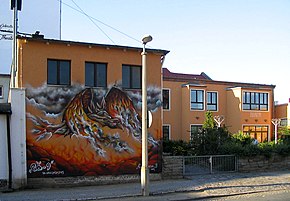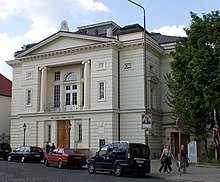Elbe-Elster-Theater
The Elbe-Elster-Theater , from 1993 Central German State Theater , was a multi-branch theater in Lutherstadt Wittenberg in Saxony-Anhalt . With 360 employees, the theater, founded in 1949 and closed in 2002, was the largest guest theater in the GDR in the late 1980s . His successor has been the Phönix Theaterwelt Wittenberg since 2004 .
history
Prehistory and foundation
The Elbe-Elster-Theater was founded on September 14, 1949 in Wittenberger Wichernstrasse 10, initially as a traveling theater through the districts of Torgau , Schweinitz , Liebenwerda and Wittenberg . The Small Theater had previously been founded in November 1945 at the suggestion of the local Soviet command . It was renamed City Theater in May 1946 . The venue was the former trade union building on Wichernstrasse.
Arthur Miller's work “All My Sons” was shown on September 15, 1949 as the opening piece in the newly created Elbe-Elster-Theater . The Kulturpalast Bitterfeld , the Stadttheater Luckenwalde , the Stadttheater Köthen (1962) and the Salzlandtheater Staßfurt soon followed as further venues . From 1959, major renovations were carried out at the headquarters at Wichernstrasse 10, which took almost three years to complete.
From the 1970s until the turn of the century
The theater's play area extended over five districts ( Halle , Cottbus , Magdeburg , Potsdam , Leipzig ) of the former GDR . In today's Saxony-Anhalt alone, 60 locations were used. The Elbe-Elster-Theater not only offered classical drama , but also had operas , operettas and cabaret performances in its program. Another mainstay was the puppet theater , which was launched in the early 1970s. In June 1971 the "Interest Group Elbe-Elster-Theater" was founded. Now 14 circles have been played. The aim of this interest group was to improve theater operations. From 1972 onwards, extensive reconstruction measures took place at the headquarters in Wittenberg, for which the ensemble members did a lot of voluntary work and which were managed by the Berlin “Institute for the Technology of Cultural Institutions”. An extension of the stage building took place in the course of the construction work. In addition, the auditorium was redesigned and the so-called “Studio 64” created a space for smaller performances and the puppet theater.
In addition to the premises in Wichernstrasse, the Elbe-Elster-Theater had other venues of its own. Since 1971 the cabaret performances of the Elbe-Elster-Theater have taken place in the so-called “Brett'l-Keller” of the Wittenberg Castle . The "island grotto" in the Wörlitz Villa Hamilton was also used for this purpose. The open-air stage in the Wittenberg castle courtyard and the open-air stage on the “Steininsel Stein” in Wörlitzer Park were used for open-air performances . Through a further reconstruction, the theater in Wittenberg was given, among other things, a revolving stage and a foyer with a restaurant between 1987 and 1988, again supported by extensive voluntary work by employees.
A short time later, the Elbe-Elster-Theater merged with the Carl-Maria-von-Weber-Theater in Bernburg in 1988 . From then on, they operated jointly as “Elbe-Saale-Bühnen Wittenberg / Bernburg” and, with 360 employees, was the largest guest theater in the GDR, which could host up to six performances a day at several venues. Five years later it was decided to break the link. However, the Elbe-Elster-Theater did not get its original name back, but from then on it appeared as the Central German State Thater Wittenberg . Even after the fall of the Wall, the theater remained true to its credo as a guest theater and went on guest tours to southern Germany , Austria , Switzerland and the Netherlands , among other places .
Decline and end
With Helmut Bläss , Germany's longest-serving theater director left the Mitteldeutsche Landestheater in 1996 . He took up his post in 1964, which Reinhold Stövesand has now taken over. Years of public discussions about the theater followed by the various institutions, because after the separation from the Bernburg location, the city of Wittenberg was now also included in the sponsorship of the theater. The personnel-intensive and thus expensive multi-branch operation caused the Wittenberg theater increasing financial problems, so that it had to cope with severe cuts. Subsidies from the Wittenberg district were discontinued. Ultimately, they even parted ways with their permanent ensemble from the 2001/2002 season.
While the Bernburg Carl-Maria-von-Weber-Theater still exists today, the Mitteldeutsche Landesthater in Wittenberg finally had to be the first theater on August 31, 2002 , despite a petition from the citizens with more than 10,000 signatures and a total of more than 1000 productions Saxony-Anhalt has been closing its doors since German reunification .
Subsequently, on May 24, 2004, the “Phönix Theaterwelt Wittenberg” sponsorship association was founded on the site of the former Elbe-Elster-Theater, which revived the location at Wichernstrasse 11a. On September 3, 2004, there was another performance on the big stage for the first time. The Brett'l-Keller cabaret is now located in the cafeteria of the Alaris Butterfly Park at Rothemarkstrasse 131.
Personalities working at the Elbe-Elster-Theater
Directors
- Udo Krams
- Hans Hardt-Hardtloff
- Harry Brown
- Harry Studt
- Gero from Wilcke
- Ernst Richter
- Helmut Bläss (1964–1996)
- Reinhold Stövesand (1996-2000)
- Jörg Iwer (2000-2002)
Well-known ensemble members (selection)
Others
- Klaus Breuing , puppeteer
- Peter Fabers , director
- Rainer Gohde , worked as a director, actor and acting director from 1991 to 1998
- Martin Hellberg , director
- Peter Kothe , set designer
- Dietmar Langberg , dramaturge
- Isabelle McEwen , French-Canadian opera and theater director
- Thomas Müller , conductor, composer and pianist
- Hans-Gerhard Templin , graphic artist
- BK Tragelehn , director
- Erich Viehweger , set designer
Web links
- Homepage of the sponsoring association "Phönix Theaterwelt Wittenberg"
- Homepage of the Brett'l-Keller association
Footnotes and individual references
- ↑ a b c d e Ingrid Bigler-Marschall: Wittenberg . In: Deutsches Theater-Lexikon - Weisbrod - Wolansky . tape VI . Saur Verlag, S. 3474-3475 . (accessed via De Gruyter Online, January 11, 2020).
- ↑ a b c d e f g h i j Helmut Bläss: Theater in Wittenberg . In: Jens Hüttmann, Peer Pasternack (Ed.): Traces of knowledge - education and science in Wittenberg after 1945 . Drei Kastanien Verlag, Wittenberg 2004, p. 273 to 283 .
- ↑ a b c d e The history of the Elbe-Elster-Theater on the website of the association "Phönix Theaterwelt Wittenberg" , accessed on January 11, 2020
- ↑ a b The next domino falls . In: Die Welt , August 30, 2000
- ↑ "Like a phoenix from the ashes". on www.theater-wittenberg.de
- ^ Website of the Brett'l-Keller association , accessed on January 12, 2020
- ^ Ingrid Bigler-Marschall: Deutsches Theater-Lexikon - Supplementary volume 5: Pe - Schad . De Gruyter-Verlag, p. 9 . (accessed via De Gruyter Online, January 11, 2020).
- ^ Ingrid Bigler-Marschall: Deutsches Theater-Lexikon - Volume IV: Singer - Tzschoppe . De Gruyter-Verlag, p. 2649 . (accessed via De Gruyter Online, January 11, 2020).
Coordinates: 51 ° 52 ′ 21.1 ″ N , 12 ° 39 ′ 4.4 ″ E



